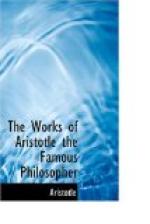As soon as the midwife hath in this manner drawn forth the child, let her put it on one side, lest the blood and water which follows immediately, should do it any injury by running into its mouth and nose, as they would do, if it lay on its back; and so endanger the choking of it. The child being thus born, the next thing requisite is, to bring away the after-burden, but before that let the midwife be very careful to examine whether there be more children in the womb; for sometimes a woman may have twins that expected it not; which the midwife may easily know by the continuance of the pains after the child is born, and the bigness of the mother’s belly. But the midwife may be sure of it, if she puts her hand up to the entry of the womb, and finds there another watery gathering, and the child in it presenting to the passage, and if she find it so, she must have a care of going to fetch the after-birth, till the woman be delivered of all the children she is pregnant with. Wherefore the first string must be cut, being first tied with a thread three or four times double, and fasten the other end with string to the woman’s thighs, to prevent the inconvenience it may cause by hanging between the thighs; and then removing the child already born, she must take care to deliver her of the rest, observing all the circumstances as with the first; after which, it will be necessary to fetch away the after-birth, or births. But of that I shall treat in another section, and first show what is to be done to the new-born infant.
SECT. II.—Of the Cutting of the Child’s Navel String.
Though this is accounted by many but as a trifle, yet great care is to be taken about it, and it shows none of the least art and skill of a midwife to do it as it should be; and that it may be so done, the midwife should observe: (1) The time. (2) The place. (3) The manner. (4) The event.
(1) The time is, as soon as ever the infant comes out of the womb, whether it brings part of the after-burden with it or not; for sometimes the child brings into the world a piece of the amnios upon its head, and is what mid wives call the caul, and ignorantly attribute some extraordinary virtue to the child so born; but this opinion is only the effect of their ignorance; for when a child is born with such a crown (as some call it) upon its brows, it generally betokens weakness and denotes a short life. But to proceed to the matter in hand. As soon as the child comes into the world, it should be considered whether it is weak or strong; and if it be weak, let the midwife gently put back part of the natural and vital blood into the body of the child by its navel; for that recruits a weak child (the vital and natural spirits being communicated by the mother to the child by its navel-string), but if the child be strong, the operation is needless. Only let me advise you, that many children that are born seemingly dead, may soon be brought to life again, if you squeeze six or seven drops of blood out of that part of the navel-string which is cut off, and give it to the child inwardly.




